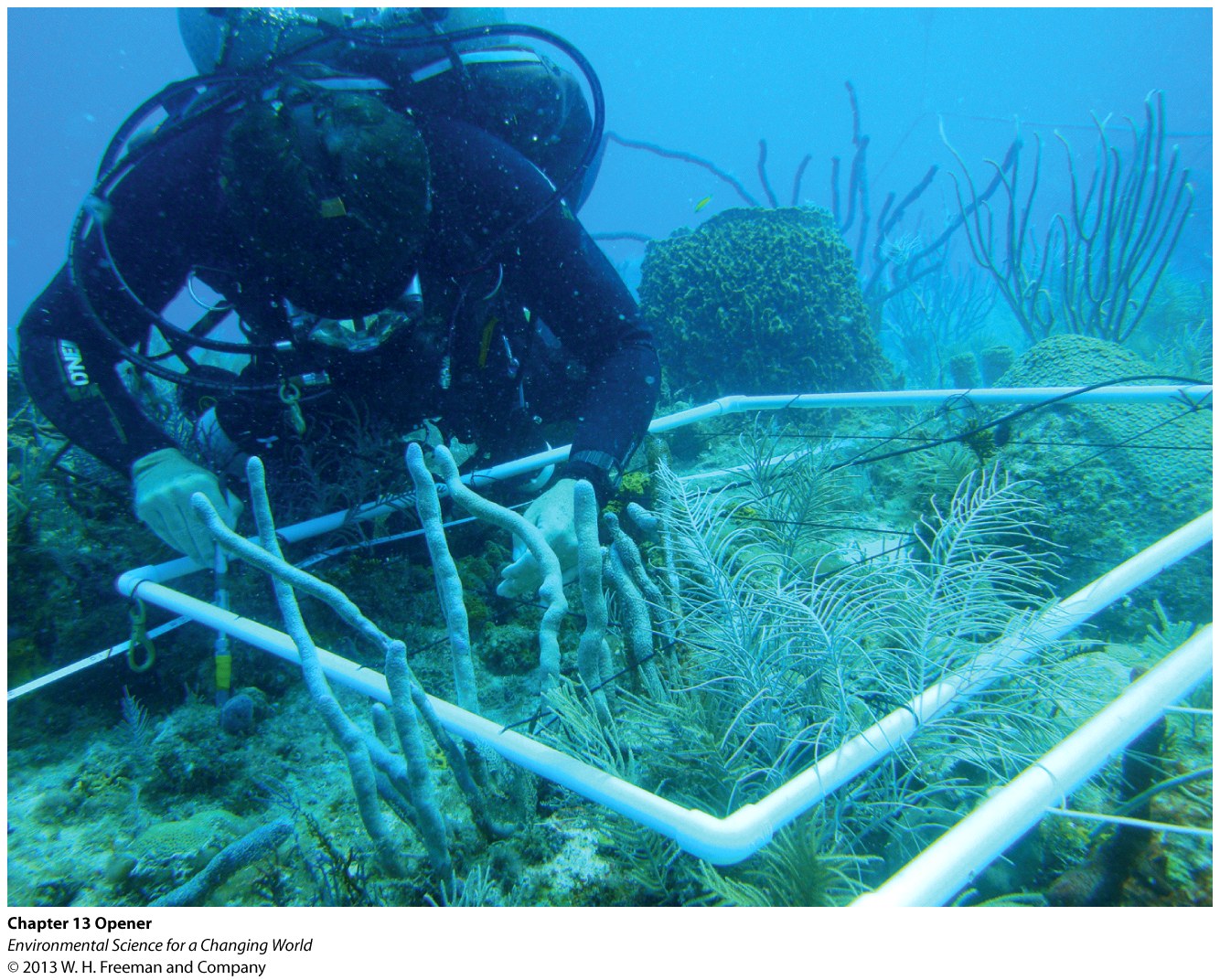
Chapter 15. Chapter 15: Marine Ecosystems
How can we reduce the threats to coral reefs...?

Guiding Question 15.5
How can we reduce the threats to coral reefs and other ocean ecosystems?
Why You Should Care
Threats to coral reefs and ocean ecosystems occur at different scales, from small activities like trawling ocean bottoms when fishing to nutrient pollution from agricultural activities on land. The main threats can be grouped broadly into habitat threats (beach development and overfishing) and chemical threats (nutrient pollution and carbon dioxide emission).
Protecting coral reefs involves action at multiple levels to slow down and ultimately reverse damage to coral reefs. We can take actions personally to minimize our impact on beaches and their reefs and take actions as nations to lower our carbon dioxide production. Recovery may be slow, but it is possible.
Click on each of the following links and read about some of the strategies being implemented to reduce threats to ocean ecosystems:
| Strategy | Ocean Ecosystem |
|---|---|
| Designate vulnerable areas as marine protected areas | Papahānaumokuākea National Monument is the largest MPA in United States waters and is listed as a UNESCO World Heritage site for its unique cultural and environmental value (http://whc.unesco.org/en/list/1326) |
| Reduce use of fossil fuel | New research on the pace of ocean acidification shows that this recent acidification is faster than at any time in the past 300 million years (http://green.blogs.nytimes.com/2012/03/02/pace-of-ocean-acidification-has-no-parallel-in-300-million-years-paper-finds/) |
| Limit development in vulnerable areas | Protecting coral reefs with the Nature Conservancy using ecosystem services as justification (video - http://youtu.be/kEbG11F4KzY) |
| Prohibit bottom trawling for fish in vulnerable areas and reduce overfishing in general | A consortium of South Pacific nations prohibit bottom trawling in their waters (http://news.bbc.co.uk/2/hi/science/nature/6627425.stm) |
| Reduce pollution | List of steps anyone can take from New Zealand’s Ministry of the Environment (http://www.mfe.govt.nz/issues/oceans/kids/reducing-pollution.html) – my fav, “only rain goes down the drain” |
1.
What would the benefit be of reducing overfishing in all areas of the ocean?
2.
Would it be useful to set aside marine reserves without also making changes to fossil fuel use or pollution release?
3.
Given how much humans enjoy coastal areas, what would be the biggest obstacle to limiting coastal development and reducing pollution?
4.
Short-Answer Questions
Threats to the ocean come from various sources, and this creates complex solutions. In the Gulf of Mexico, there is a complex relationship between fishing activities and sea turtles. Sea turtles range in size from 80 lbs (Kemp’s Ridley turtle) to over 1,000 lbs (leatherback sea turtle). They are excellent fish predators, and where fish can be found, the sea turtles are nearby. This causes competition for the fish between the turtles and humans.
Fishing technology has advanced, and modern drift-net techniques employ huge nets that can trap turtles and drown them. Many of these sea-turtle species are now threatened and endangered. Turtle exclusion devices (TED) are escape “hatches” in nets that are turtle-sized. They are expensive and some fish do escape from them, but their use in the Gulf by shrimping boats was mandated in 1987.
The challenge here is that the TEDs can be bypassed, disabled with a simple rope tie, or simply not deployed. Enforcement of the use of TEDs is left to states, and some (such as Louisiana) disagree with the regulation and refuse to enforce it.
1. It is estimated that turtles are caught in nets once every 300 hours that nets are deployed. Given that, why would well-intentioned shrimpers disable their TEDs?
2. If an area has a federally endangered species of turtles, should the federal government (rather than the state governments) enforce the use of TEDs?
3. Some estimate that up to 10% of the catch escapes through the TEDs. Should the state or federal government compensate shrimpers for using TEDs to protect endangered species?
2. Federally listed endangered species are protected by the Endangered Species Act. One component of that law is habitat protection and recovery, and this enforcement certainly could be part of the recovery. Unfortunately, there is no direct enforcement of the Act for private lands, and this would be a great legal precedent.
3. Given that TEDs are mandatory but their use is not uniform, this strategy (if it could be assured that TEDs were being used) would be more effective than enforcement officers.
Activity results are being submitted...